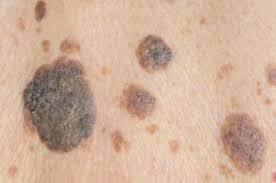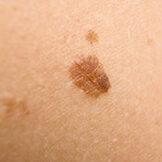SKIN TAGS & IMPERFECTIONS
FOR PERMANENT REMOVAL OF MINOR SKIN IRREGULARITIES

Improve your skin’s appearance by reducing or eliminating unwanted skin imperfections. Some, but not all, of the imperfections we are able to treat are: skin tags, milia, angiomas (cherry angiomas, spider angiomas, ruby spots, blood spots), pigmented spots (age spots, liver spots, etc), keratoses, visible facial capillaries (spider veins, threaded veins, broken capillaries) angiokeratomas, moles and some warts.
The Superfrecator direct high-frequency technology is an amazing affordable non-laser treatment for minor skin irregularities. It precisely treats each irregularity without the use of lasers, cutting, burning, or freezing. The treatment utilizes a probe to transmit electric current to effectively vaporize and dehydrate the skin irregularity with little or no downtime and no damage to surrounding tissue. The non-invasive process targets and draws moisture from the lesion creating very small crusts that flake off in a few days.
Types of Skin Imperfections

Skin Tags
Skin Tags are benign flaps of skin. They are usually darker than your skin and often found on the neck or underarms. Skin tags can be flat or protruding.
Common Causes
Skin tags are found on women and men of all ages. They are thought to appear on areas of the skin prone to rubbing against skin or clothing. Being overweight also increases the occurrence of skin tags.
Milia
Milia are tiny white bumps on the skin. Milia look like whiteheads and are often found around the eyes and nose. They are keratin-filled cysts, which feel like a grain of sand under your skin. They don’t have an opening at the surface so they can’t be extracted like whiteheads.
Common Causes
Milia can be found in babies and people of all ages. They can be a hereditary trait. Some milium will disappear without treatment, and exfoliating can also help. Others are often persistent and need to be extracted by a professional.



Spider Veins (Telangiectasia / Dilated Capillaries)
Visible facial capillaries are dilated capillaries that have lost their elasticity and become permanently enlarged. They may form as lines or as dots of
redness. The name “spider veins” is given for the spider-like appearance of some—with red centers and little tentacles emerging from the middle.
Common Causes
Visible facial capillaries (blood vessels) often concentrate on the nose, cheeks, and chin. The main causes are sun damage, injury, medication, and
aging. Nearly all fair-skinned people are prone to these unattractive blood vessels, which gradually start appearing in their mid-thirties.
Cherry Angiomas
Cherry angiomas are benign red or purple skin growths. They may be raised or flat and are usually round or oval-shaped. They can appear anywhere on the body, though they are most common on the torso
Common Causes
Cherry angiomas get their bright, cherry-red, or purple color from the dilated capillaries they're made up of. Cherry angiomas are one of the more common skin growths and, while children can have them, they're most common in adults over the age of 30.
Genetics play a role in how likely you are to have cherry angiomas. If your parents and grandparents have them, there’s a good chance you will, too. Exposure to certain environmental chemicals and gases can also cause cherry angiomas to appear in clusters. They're also more common in certain climates.


Seborrheic Keratoses
Seborrheic keratoses are roundish or oval-shaped patches on the skin with a “stuck-on” appearance. They are sometimes described as waxy or scaly. They are raised above the skin and even when they are flat you can feel them with your finger. They are usually brown, but can also be black or tan, and less often, pink, yellow, or white. They often appear in numbers.
Common Causes
We don't know exactly why these growths occur, but we can look at the circumstances that often go along with it. The first is age: seborrheic keratoses are especially common in adults over 50, and they tend to multiply as people get older. Some studies suggest that sun exposure may increase their occurrence. They also appear more frequently in families, which suggests that genetics may play a role. They are not viral or bacterial. They don’t spread and they aren’t contagious.
Moles
Moles are normal skin growth that develops when pigment-producing cells (melanocytes) grow in groups. Moles are smooth and can appear in a range of different colors, sizes, and shapes. A note is required from your Dr. declaring that it is safe to treat.


Pigmented Spots (Liver Spots & Old Age Spots)
Pigmented spots are flat brown or black spots. They appear on sun-exposed areas of the body, such as the face, shoulders, back and back of the hands.
Common Causes
Pigmented spots usually occur as we age and may darken with more sun exposure. Heredity seems to play the most significant role in the development of pigmented spots.
Warts
Warts are noncancerous growths that develop on your skin or mucous membranes (soft, fleshy areas such as inside your mouth and genitals). They vary widely in shape and appearance — some are round, some are flat, and some are threadlike. They’re usually not a problem, but sometimes they can be painful or make it difficult to walk (like if you have a wart on your foot). You also might feel self-conscious about how the warts look.
Common Causes
Common warts are caused by the human papillomavirus, also called HPV. There are more than 100 types of this common virus, but only a few cause warts on the hands. Some strains of HPV are spread through sexual contact. But most are spread by casual skin contact or shared objects, such as towels or washcloths. The virus usually spreads through breaks in the skin, such as hangnails or scrapes. Biting your nails also can cause warts to spread on your fingertips and around your nails.
Each person's immune system responds to HPV differently. So not everyone who comes in contact with HPV develops warts.


I strongly encourage you to have your Dr. examine any spot that is questionable or
suspicious. I will not treat any lesion that I feel is not safe to do so.
BOOK
Book Now & Let Me Rid You of Your Skin Imperfections........Once and For All !
